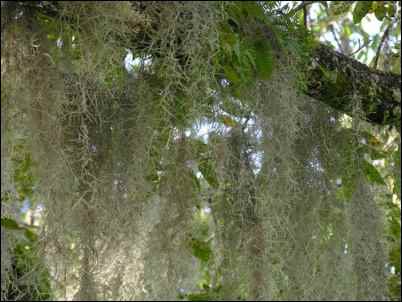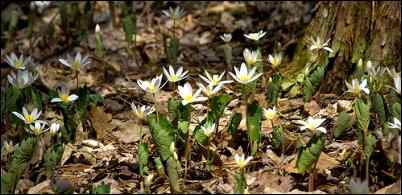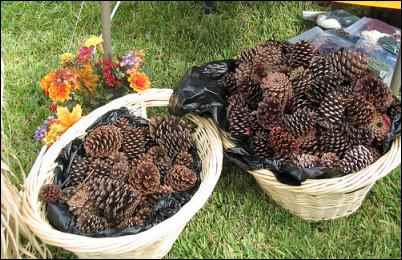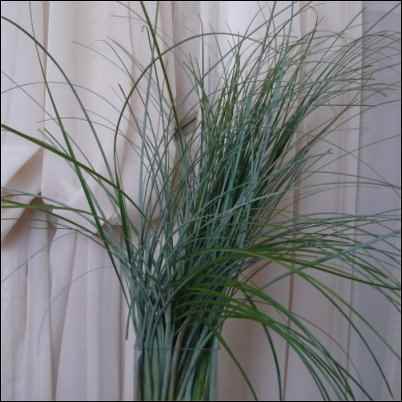No matter where you live, you can create an income stream, or supplement your existing income by harvesting the natural products you find all around you. A walk through the woods and fields can yield a bounty of products like cones and seeds, forest botanicals, aromatics, medicinals, greenery, and mushrooms, to name a few. If you’d like to try your hand at this wildcrafting, there are several preliminary steps to take:
Conduct a personal evaluation:
- Why do you want to start a wildcrafting business?
- What do you hope to gain monetarily-how much money do you want to make?
- If you expect to make $1000 a month, is it feasible?
- How will you go about collecting your products?
- Will you have help or will it be a solo operation?
- Conduct a market evaluation:
- What can you harvest from your area?
- Who will buy your product?
- When and where will you harvest?
- Where will you find your buyers?
Identify your buyers:
- What are their product specifications?
- How much will they buy?
- What kind of quality are they looking for?
- What characteristics, such as size and color, do they want?
- What is their price range?
- What is their damage allowance as pertains to insects, or environmental damage?
Wildcrafting deals with products like mushrooms and floral greenery that have a limited shelf life, and seasonal demands. You’ll need to know all these things because your business will depend on coordinating the timing of your harvest with the needs of your buyers. Educate yourself on local, state, and federal laws and regulations pertaining to edible products, potentially noxious weeds, and any products you’ll be shipping out of state. Commercial harvest of public lands usually requires a permit as well.
It’s your responsibility to learn all you can about the products you intend to harvest. The U.S. Department of Agriculture’s Office for Small-Scale Agriculture has fact sheets on mushrooms, herbs, woodlots, et cetera. You can also get their newsletter, a directory and a video on small-scale agriculture.
 Greenery and Floral Products
Greenery and Floral Products
Some of the most popular products you can harvest are the greenery and floral products you see in stores all year round. Most of these products come from the Pacific Northwest. Some very popular products include:
Beargrass: a type of lily, used in basket making and now used extensively in floral arrangements. Beargrass has long-stemmed, coarse, low-lying leaves that lend themselves too many applications; these leaves are very durable and accept dyes easily.
Ferns: Ferns are harvested year round, but the sword fern is the most harvested. Sword fern is found mostly in the Pacific Northwest.
Evergreen Huckleberry: Floral greens suppliers like to use the two main types of this fern. One type has deep green, glossy leaves and one kind has leaves with a red tinge; it’s known as red huckleberry.
Moss: A huge seller in its many forms, including angel hair moss, sheet moss, and Spanish moss. Moss grows in a variety of locations, from the swamps to the mountains; harvest it in the summer when the moss is the driest.

Market Considerations
You need to harvest as many different kinds of greenery as possible; don’t become dependent on the seasonal items. The popularity of this category of wildcrafting is on the rise. State and Federal government agencies have sold them under a commercial permit system, under this system the government agency in charge establishes prices of and conditions for the permit at the beginning of the season. Most of their permits have time limits and minimum purchase amounts.
Distribution
Volume sales are the key to making money with your harvested products. Wildcrafting is not a get-rich-quick business; you must build it slowly. You’ll be able to sell in volume to wholesalers; a potential source of information is The Wholesale Florist and Florist Supplier Association in Arlington, VA.
Forest Botanicals for Flavorings, Medicinals, and Pharmaceuticals
The number of plants in our forests and woods that you can market for culinary uses is almost limitless. Consider herbs; they’re used as seasoning, to add color and aroma to the foods we eat every day. They’re also used in coffee, tea, and soft drinks and more and more as natural food preservatives. Edible greens, roots, and tubers can also be harvested and sold to the culinary market.
Marketable culinary products include: burdock leaves and roots; dandelion leaves, flowers, and roots; plantain, sheep sorrel, wild garlic and onion, asparagus shoots, beebalm leaves, and elderberry flowers.

Medicinal and Pharmaceutical include: wild mint, boneset, wild ginger, bloodroot, mayapple, foxglove, sassafras, sumac and western yew. This list is in no way all inclusive. There are many herbs and plants with medicinal properties; listing them all is beyond the scope of this article. The herbs and plants you might harvest are being used by pharmaceutical companies to manufacture over-the-counter medicines and naturopathic remedies. Botanicals that have medicinal uses are also put into our foods, cosmetics, dyes, and dried florals. There are many other uses for these plants as well.
Market Considerations
Culinary: The market for culinary products is large for you, the wildcrafter. The demand for herbs and spices from food manufacturers and spice companies continues to grow. Your best chance of making a profit here is with direct and/or bulk marketing; consider a roadside stand, farmers markets, gift baskets or mail order through the Internet. You can also sell directly to retail stores, local and small manufacturers, and restaurants.
Medicinal and Pharmaceutical: Lots of new market opportunities are being created for the wildcrafter these days. Natural remedies and nutritional supplements continue to grow in popularity, opening the door wide for the natural harvester. Plants with medicinal properties are being sold as alternative healthcare products or supplements in the retail market and to mainstream pharmaceutical firms. A great example is the anticancer drug Taxol; it originates from the Pacific yew tree.
The annual Whole Foods Source Directory lists a number of different wholesalers, retailers and manufacturers who purchase herbs and spices. It also lists sources for warehousing and transportation. To get the word out that you have botanicals for sale, do a bulk sheet mailer accompanied by a sample of the product for sale.
Harvesting, Drying, Storage and Distribution: It may take some time to find the right place to harvest your botanicals, since a minimum of two to four acres of the plant is about what you’ll need. Be sure you get permission from the landowner before you start harvesting; it’s a good idea to alert the local authorities about what you’re doing as well. Do your best to make sure the plants you want to harvest aren’t contaminated by any chemical; you can do this by contacting the Agricultural Extension Agency in the area. Ask about the local laws and regulations concerning agricultural chemical use.
An often overlooked wildcrafting resource is the slash material left over after logging. If you follow logging crews, you can sometimes recover entire plants, barks, roots, and leaves. Establish communication with loggers to find out where certain plants might be found.
A very important step is the drying of your harvest; removing moisture will help ensure your plants won’t mildew and rot and reduce the plant’s effectiveness. Each part of the plant needs to be dried so that the volatile oils and cosmetic integrity aren’t lost. Some tried and true methods are solar drying, drying sheds, and shade-drying methods.
Distribution
After they’re processed and dried, most botanicals are lightweight, making them easy to store and ship. Shipping costs won’t be a concern since you’ll be able to get pretty high prices for them. Check on the Internet for large buyers of botanicals.
Equipment Needs
Permits are required for you to harvest commercially from public lands, if indeed it is permitted at all.
If you find a promising spot, you’ll need to find out who owns the land, whether it’s a government, private individual, or company, get their permission and obtain a permit validation from the appropriate authority. Once you start harvesting, keep this permit on your person at all times.
You’ll need a map of your area and a legal description of the harvest site; the County Assessor’s Office can provide you with the legal description and ownership of any particular tract of land
Mushrooms
The biggest commercial use for mushrooms is as a food source. But many mushrooms are poisonous or otherwise inedible, so you as the wildcrafter must know how to identify them. Some mushrooms you might find in the woods are used for medicinal purposes as well.
Learn to Identify these Mushrooms: Armillaria, Agaricus, Clavaria, Lactarius, Pleurotus, and Rosites.

Market Considerations
There is a market for wild edible mushrooms that can be harvested from the forest. The most important and profitable ones are the morel, Chanterelle, Matsutake, Boletus, and hedgehog.
You can also cultivate your own mushrooms at home. Several different kinds of mushrooms are being cultivated as home businesses; the investment is a small one. Mushroom cultivating kits are on the market as well.
Distribution and Packaging
Once you have made sure that the wild mushrooms are not poisonous, cut out any damaged areas, wipe the soil away with paper towels and then soak them for a few hours in saltwater. This will help to get rid of any insects that might have hidden between the gills. You can store wild mushrooms in the same fashion as normal mushrooms, by placing them in a paper bag in the fridge. Either freeze or dry the wild mushrooms if you are planning on storing mushrooms for the long term. You can dry the wild mushrooms in an oven or dehydrator, at 100-150 degrees F. Dehydrated mushrooms should be crisp and crunchy, like potato chips. Store these dried mushrooms in an airtight container. Soak in warm water before use.
Pine Cones and Seeds
Two very popular and easy to obtain wildcrafting items are pine cones and seeds; they’re used often in the floral, wreath, and potpourri products industry. They can also be used in gift and fragrance items, as decorations, jewelry, and bird feeders.
Pine cones can be waxed and used as fire starters, decorations, or crushed and molded into presto-log shapes to use as fire starters.

The most popular cones are: Douglas fir, sugar pine, redwood, Ponderosa pine, digger pine, and hemlock. Others that you can harvest include: slash pine, loblolly pine, white pine, red pine, and jack pine. The pine cone market is flexible; they’ll make substitutions if one type of pine cone isn’t available. You’ll probably have better results marketing the larger cones in the floral market, but there is also demand for small cones in the wreath-making industry. Potpourri mixtures use the scales from some fir cones, like the noble fir.
Seed Cones
The major users of seed cones are the Forest Service and the Bureau of Land Management, large, private landowners like Boise Cascade and Louisiana Pacific. State seed tree nurseries also use them.
Market Considerations
Seed cone crops are cyclical and very seasonal. You only have a very narrow window of time in which to harvest: mid to late August through September. The Forest Service pays well for seed cones, seed companies usually have designated agents in many rural communities.
Decorative Cones
The four main places in the United States for decorative cone sales are Tennessee, Minnesota, the East Coast, and California. The lodgepole pine is one of the best sellers because of its availability, and the longleaf pine is popular in the south because of its size. It’s generally better to sell to brokers or wholesales, and this goes for any wildcrafted product, rather than try to deal directly with the large manufacturers. These brokers and wholesalers have experience dealing with problems that come up with large manufacturers; this leaves you free to harvest more products.
Some wholesalers only buy in large quantities; others buy whatever you have harvested. Cones can be purchased by the case, but more often by the trailer load of 2,000 to 20,000 pounds.
Distribution and Packaging
Most cones are packaged in boxes, burlap, or polypropylene sacks.
Equipment Needs
Most harvesting of cones is done by hand; cones like pine and spruce can be gathered from directly under the trees from which they’ve fallen. Be sure to gather them soon after they fall, or they’ll turn black. If your cones do turn black, you’ll have to clean them before they can be sold. You can rake small cones from the branches of pine trees, or shake the tree and lay a tarp underneath to catch the cones.
For further information contact the US Department of Agriculture.


 Greenery and Floral Products
Greenery and Floral Products








This is truly so irresponsible. A lot of the native plants mentioned are extremely endangered (Ginseng especially) and should be protected and respected not exploited for a quick buck at the expense of destroying entire ancient ecosystems. Also as a WHITE SETTLER on STOLEN NATIVE LAND it is never okay to get rich off plants that will never belong to you. These plants are sacred and not just commodities for you to take and take and take. Grow a garden. REPLANT native plants instead of stealing them. Connect with plants from your OWN lineage. This is encouraging deforestation and it is so disrespectful to the plants that give us so much already. Please take this article down it is NOT OKAY.
Hello,
It’s your right to feel as you do. We are all citizens of the world and the plants that God created are there for all of us. You sound like a person who wants to censor the world because it doesn’t agree with your politics. Well, I don’t agree with your politics, but I won’t tell you that you aren’t okay. God Bless and Go Wildcrafting!
Regards,
Catherine Lugo
There IS such a thing as being a responsible and educated collector. By collecting/harvesting the right way, the consumer and the seller will benefit. Many people rely on the health benefits that plants from nature have provided over the years. I don’t think a person should be so money greedy that no regard is given to the amount taken in one spot, unless there is such an enormous abundance to share, but that’s where responsibility comes in (There are also harvesting regulations that need to be followed). There are nature preserves in many or most states, as far as I know, where endangered plants can be safe and protected. I have one more thing to say. For some people, just getting out in the woods, or the fresh, open air is a health benefit. It feels GREAT to dig in the earth. Dig for health. Not wealth! ( I don’t know if I just made that up on the spot, or not, but it sounded right!) ~Carrie E. in MN~
In the European Christian capitalist philosophy, nature was given by God for humans to exploit however they choose. When colonialism began, who counted as humans went up for debate. It was decided that people of color weren’t quite humans, so removing them from their land, massacring them, and enslaving them was all on the table. Lucky for capitalists. In much of the rest of the world, the philosophy has been quite different. All people are part of nature, so exploiting nature is self-harming. In many parts of the world today, even, when one enters the forest in order to hunt for the food that’s necessary to survive, a sacrifice must be given at the entrance to the forest in order to show gratitude for the means of survival. In this philosophy, one never takes more than they need because everyone, and everything, is connected. So, if one takes too much, that act of taking hurts the takers, themselves, and it hurts the people whom they love. This lesson, by which people can learn to not be exploitative, not be greedy, and not undermine the means of others’ survival is a lesson that many people still have the opportunity to learn. Let’s hope that they learn it quickly!